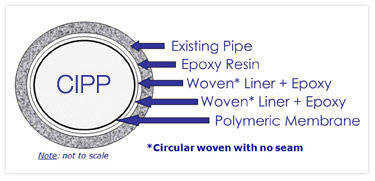What is CIPP?

CIPP, which stands for cured-in-place-pipe lining has been a method of pipe repair and replacement used by U.S. plumbing contractors for the past 35 years. Considered just one of the different pipe repair methods referred to as Trenchless Technologies, the CIPP lining is a preferred option compared to the older way of repairing a broken, failed or cracked sewer pipe.
Is CIPP the Right Option?
There are many benefits of CIPP. Foremost, it is less expensive and more efficient than the traditional method of digging up the pipe and removing the offending part. In fact, CIPP leads to very little surface disruption and is used for rehabilitating almost any type of pipe that may be present, including corrugated metal pipe, concrete pipe, HDPE, ABS, PVC, Orangeburg, cast iron, and clay. First invented in England, the CIPP process has been used to restore millions of feet pipe.
The CIPP Process
The construction of CIPP liner consists of tubular layers made with non-woven polyester felt. The exterior coating is made of polyurethane. During a process referred to as wet-out, the felt is infused with a catalyzed thermosetting resin mix. The felt then acts as the resin carrier, providing flexible strength to the liner when it is finished. When complete, the pipe is taken to the installation site inside of a cold/refrigerated truck.
Once at the site of installation, the CIPP liner is placed inside of the host pipe through an inversion process using either water or air. Alternatively, it can be winched into place. Once in the proper position, either air pressure or a column of water inflates the liner and press this material against the main pipe’s wall. After it is completely inflated, hot water or steam circulates in the liner and begins the thermosetting process, allowing the material to harden or cure. Once cured, the liner cools down slowly to prevent the material from shrinking.
Hiring a Professional Installer
The CIPP process should never be performed by an amateur. Taking the time to find an experience professional service that understands the process is essential to a correct installment. This will ensure the work is done right and that no future issues will arise.
CIPP is not a new process. However, it is just now becoming more widely used. If you have noticed an issue with a pipe, calling for an evaluation will be the best course of action. You should never let an issue go on without intervention. Damaged pipes lead to serious damage and sewage back up into the plumbing system of your home or business. Call a professional who is experienced with CIPP and see the difference it can make.